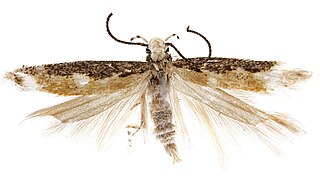Ephelictis is a genus of moths in the family Gelechiidae.

The Depressariinae – sometimes spelled "Depressiinae" in error – are a subfamily of moths in the superfamily Gelechioidea. Like their relatives therein, their exact relationships are not yet very well resolved. It has been considered part of family Elachistidae sensu lato or included in an expanded Oecophoridae. In modern classifications they are treated as the distinct gelechioid family Depressariidae.
Dichomeris plasticus is a moth in the family Gelechiidae. It was described by Edward Meyrick in 1904. It is found in Australia, where it has been recorded from New South Wales.

Gelechiinae is a subfamily of moths in the family Gelechiidae. It was described by Henry Tibbats Stainton in 1854.
Aristotelia pamphaea is a moth of the family Gelechiidae. It was described by Edward Meyrick in 1904. It is found in Australia, where it has been recorded from New South Wales.
Megacraspedus chalcoscia is a species of moth of the family Gelechiidae. It was described by Edward Meyrick in 1904. It is found in Australia, where it has been recorded from South Australia and Western Australia.
Megacraspedus coniodes is a moth of the family Gelechiidae. It was described by Edward Meyrick in 1904. It is found in Australia, where it has been recorded from South Australia.
Megacraspedus euxena is a moth of the family Gelechiidae. It was described by Edward Meyrick in 1904. It is found in Australia, where it has been recorded from Western Australia.
Megacraspedus hoplitis is a moth of the family Gelechiidae. It was described by Edward Meyrick in 1904. It is found in Australia, where it has been recorded from Western Australia.
Megacraspedus inficeta is a moth of the family Gelechiidae. It was described by Edward Meyrick in 1904. It is found in Australia, where it has been recorded from New South Wales and Tasmania.
Megacraspedus ischnota is a moth of the family Gelechiidae. It was described by Edward Meyrick in 1904. It is found in Australia, where it has been recorded from Western Australia.
Megacraspedus isotis is a moth of the family Gelechiidae. It was described by Edward Meyrick in 1904. It is found in Australia, where it has been recorded from Western Australia.
Megacraspedus melitopis is a moth of the family Gelechiidae. It was described by Edward Meyrick in 1904. It is found in Australia, where it has been recorded from Western Australia.
Pyncostola actias is a moth of the family Gelechiidae. It was described by Edward Meyrick in 1904. It is found in Australia, where it has been recorded from South Australia, Western Australia and Tasmania.
Pyncostola stalactis is a moth of the family Gelechiidae. It was described by Edward Meyrick in 1904. It is found in Australia, where it has been recorded from Western Australia and Tasmania.
Epiphthora megalornis is a moth of the family Gelechiidae. It was described by Edward Meyrick in 1904. It is found in Australia, where it has been recorded from Western Australia.
Epiphthora belonodes is a moth of the family Gelechiidae. It was described by Edward Meyrick in 1904. It is found in Australia, where it has been recorded from Western Australia.
Epiphthora drosias is a moth of the family Gelechiidae. It was described by Edward Meyrick in 1904. It is found in Australia, where it has been recorded from South Australia.
Pexicopia nephelombra is a moth of the family Gelechiidae. It was described by Edward Meyrick in 1904. It is found in Australia, where it has been recorded from Queensland.

